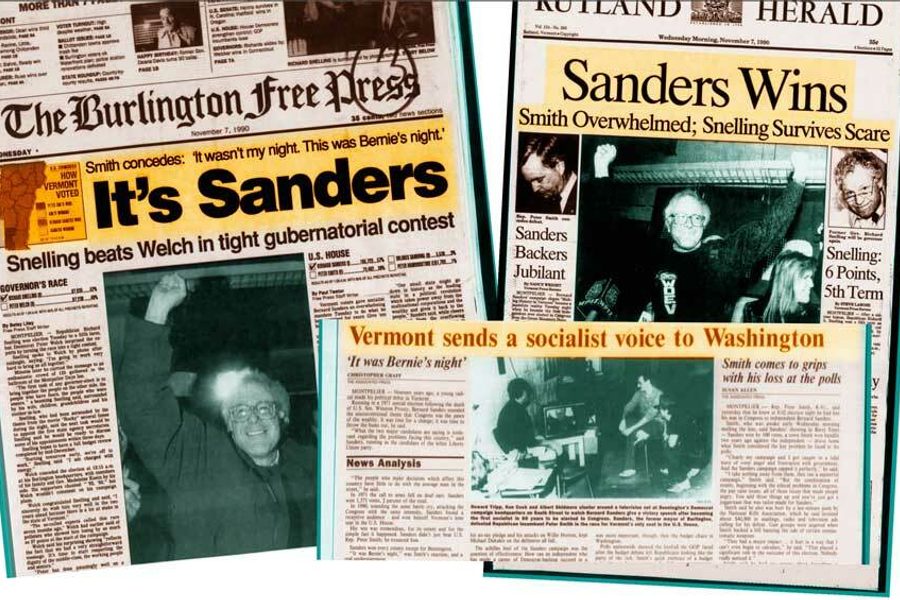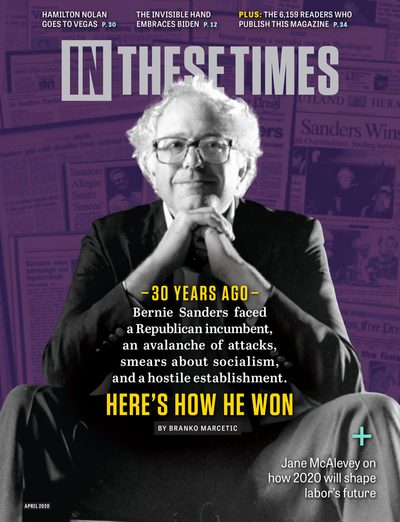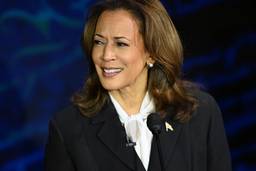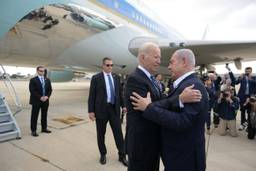How Bernie Beat Polling and a Smear Campaign To Win His First National Office
Sanders faced personal attacks and was down 10 points against a moderate Republican. He won.
Branko Marcetic

As soon as Vermont Independent Sen. Bernie Sanders became a leading contender for the Democratic presidential nomination, questions began to swirl around his candidacy — and perhaps none looms larger than whether a democratic socialist can beat a Republican.
Before he exited the presidential race, Pete Buttigieg, former mayor of South Bend, Ind., charged that Sanders “believes in an inflexible ideological revolution that leaves out most Democrats, not to mention most Americans.” At January’s presidential debate in Iowa, then-candidate Sen. Elizabeth Warren (Mass.) claimed she was “the only person [on the stage] who has beaten an incumbent Republican any time in the last 30 years.”
The pundit class has piled on, too. David Frum, a speechwriter for President George W. Bush, charged that Sanders “has never fought a race in which he had to face serious personal scrutiny.” Fellow Iraq War supporter Jonathan Chait writes that Sanders’ “vulnerabilities are enormous and untested,” adding that he “has never faced an electorate where these vulnerabilities could be used against him.”
In truth, however, Sanders has faced “serious personal scrutiny” against an incumbent Republican — and won. His 1990 election to Vermont’s single House seat (29 years and 5 months ago, but who’s counting) marked the first time in 82 years that a GOP congressmember in the historically Republican state had been ousted. Sanders went on to 30 years of electoral success as a self-described democratic socialist.
Sanders’ 1990 opponent, a moderate Republican in the era of President George H.W. Bush, was no Donald Trump, a far-right xenophobe. Yet Sanders faced similar challenges then as now: a vastly better funded opponent with the advantage of incumbency; a media landscape and Democratic Party establishment that ranged from skeptical to actively hostile; a reluctance from major unions to back him; accusations that his plans didn’t add up; and attacks that cast him as a hypocrite, complete with redbaiting and character assassination.
How Sanders won that House seat in 1990 is telling — and may offer a glimpse of how Sanders, the campaigner, would fare in November 2020.
The House Divided
In 1990, Sanders was an eight-year mayor of Burlington who had suffered two defeats for higher office. He lost his bid for governor, to Democrat Madeleine Kunin, in 1986, and his first House race, to Republican Peter Plympton Smith, in 1988. Labelled a “spoiler” candidate (“a disgusting word,” Sanders later said) for much of 1988, he was projected to win on election night — before being overtaken by Smith. (Sanders would quip to Rachel Maddow decades later, “The Democrat was the spoiler, not me.”)
“[Sanders] was emotionally crushed by that [loss],” John Franco, a Sanders staffer in Burlington, told the Rutland Daily Herald.
After Sanders’ fourth term as Burlington mayor ended in April 1989, he took a sabbatical from politics, traveling to Cuba and Nicaragua and taking up a visiting professorship at Hamilton College.
But members of the Burlington-based Progressive Coalition, a group of Sanders supporters working to become a third force in Vermont politics, urged him to run for governor again in 1990. A nervous Kunin reportedly directed allies to push Sanders toward the House race instead, and Vermont’s Democratic speaker of the House, Ralph G. Wright, warned he would oppose Sanders’ gubernatorial bid. Sanders weighed his options. In March 1990, with internal polls reportedly showing Sanders within striking distance of incumbent Smith, he announced his House campaign.
“The stakes were high,” says Steven Rosenfeld, Sanders’ press secretary for that campaign and now a national political reporter at the Independent Media Institute’s Voting Rights Project. “He felt if he didn’t win that race, he wasn’t sure what his political future might be.”
A nationwide right turn had just seen President Ronald Reagan pull off two historic landslides, and Vermont was still largely GOP territory. Between 1854 and 1988, it had voted for a Democratic presidential candidate just once, for President Lyndon Johnson in 1964.
With a 98% re-election rate in the House, incumbents, as always, had the advantage. An incumbent congressmember hadn’t been beaten in Vermont since 1960. A GOP congressmember hadn’t been booted from office in the state since 1908.
Sanders didn’t do himself any additional favors by running as an Independent. An Independent hadn’t sat in Congress since Virginia Sen. Harry Byrd left office in 1983.
Characteristically, Sanders swore off funding from corporate political action committees (PACs), choosing small-dollar donations from supporters instead. He acknowledged Smith would “be very difficult to beat” with access not only to his personal wealth but “to all the corporate money in America.”
Sure enough, Smith rejected a proposal from both Sanders and the Free Press for a campaign spending limit and raised tens of thousands of dollars from corporate PACs, including those of Philip Morris, Amoco and United Technologies. Sanders, who in 10 election campaigns over 18 years had only taken one PAC contribution (worth $300), called Smith’s PAC money “an outrage” and “an insult to democracy.” Without a campaign spending limit in place, Sanders ultimately vowed only to take PAC money from organizations like unions and groups agitating for peace, healthcare reform and the environment.
As a GOP House member, Smith had spent two years positioning himself as a “Vermont moderate,” racking up progressive votes on gun control, the environment and other issues, which earned him the endorsement of the League of Conservation Voters before Sanders even announced. Later, the Sierra Club and abortion rights group NARAL backed Smith.
Most of Vermont’s prominent Democrats swung their support behind Sanders, but some powerful Democrats (just as today) saw him as dangerous and out of step. Sanders’ years of railing against the Democratic Party, along with Smith’s voting record, prompted a string of defections. Former Gov. Thomas Salmon asked Democrats to join in a “one-time exodus from the Democratic Party” to vote for the Republican, in order to send Sanders “a message from Democrats that he will not soon forget.” Others urged support for neither, such as 1988 Democratic Senate candidate Bill Gray, who feared Sanders’ victory would help ignite a third party to challenge Democrats.
Further complicating the race was the decision of Dolores Sandoval, a professor at the University of Vermont, to enter as a Democrat, much to Sanders’ chagrin. Sandoval quickly began attacking Sanders, claiming his “Independent” label would be a liability in Washington and calling him a hypocrite for seeking Democratic Party support.
From All Sides
For much of 1990, the Sanders campaign faced a series of negative stories.
“Bernie never had a friendly relationship with the biggest media outlets at the time,” Rosenfeld says. “He had a very testy relationship with the Associated Press, because he felt they were biased against him.”
But true to style, Sanders frequently hit back at critics. When newspapers and opponents accused him of hypocrisy for soliciting money from progressive PACs— “It’s getting hard to distinguish between Sanders and the bad guys,” wrote the Brattleboro Reformer—Sanders continued to contrast his donations from “people whom I philosophically agree with” against Smith’s funding from corporations who “have wrought havoc on the environment, [dodge taxes] … and have treated their workers with contempt.”
When a Reformer op-ed hit Sanders for not voting in the September Democratic primary, he countered that, had he voted, “I would have been called a hypocrite for voting in a party primary in which I don’t belong.”
When the AP calculated Sanders had overestimated how much money a 10% tax hike on the wealthiest Americans would raise, Sanders acknowledged the error and complained they were missing the larger imperative, the need to raise taxes on the rich.
When newspapers reported on Sanders’ tax returns, which showed he and his wife, Jane, had made more than $85,000 in 1989 (around $180,000 today), Smith suggested Sanders was among the wealthiest 10% and not serious about his tax plan. Sanders complained about Smith’s lack of similar transparency and responded, “We own one house. My wife and I took out a loan to send our children to college.”
One kerfuffle concerned how the Sanders campaign classified some staff members as independent consultants rather than employees, in an alleged attempt to avoid state and federal taxes. The staffers insisted they had sought the status themselves and paid their own taxes, and it soon emerged that everyone — even then Lt. Gov. Howard Dean and longtime Sen. Patrick Leahy — had engaged in the practice. That included Smith, who had paid a single employee under this arrangement almost as much as Sanders had paid his entire 1988 staff. Even so, Smith and his campaign wasted no time in painting Sanders as a tax-the-rich hypocrite who wanted to avoid taxes himself. In response, Sanders accused Smith of “gutter politics” and called on him to “come back to the high road of Vermont politics that you and I have shared for many years.”
After Sanders won the June 1990 endorsement of Vermont’s largest union, the 7,800-strong chapter of the National Education Association (NEA), news coverage instead focused on its top-down endorsement process. Rather than polling its members, the union’s board of directors chose Sanders through the same (undemocratic) method it had always used.
This time, however, the media extensively covered the disgruntlement of the rank-and-file teachers. The Reformer quoted one Smith-supporting teacher saying that, “even if they endorsed Peter Smith, I really, honestly, would tell you that it was unfair.” Sandoval decried it as “sneaky, power play politics” and likened it to “a coup attempt.”
As in 2020, Sanders got more traction in 1990 with local unions than with wary national labor organizations. The national NEA rejected the Vermont chapter’s endorsement, electing to stay neutral because of Smith’s decent voting record. In response, over 10 days, teachers around the country raised $3,001 for the Sanders campaign, helping to offset the $5,000 Sanders lost out on through the reversal, handing the money over in a stack of bills and checks held together with a rubber band.
Sanders suffered another national union-related setback after a labor PAC funding competitive House races declined to endorse him. Even so, Sanders won the support of many Vermont unions. As his campaign gained momentum, the AFL-CIO came on board.
Perhaps the campaign’s biggest obstacle, however, was the outbreak of the Gulf War in August 1990, with Saddam Hussein’s Iraq invading neighboring Kuwait. The conflict scrambled the Vermont House race, shifting the discussion away from Sanders’ favored terrain of economic inequality and toward foreign policy.
Sanders, who had spent months calling for a five-year 50% cut to military spending (“We don’t need to spend $140 billion a year to defend Western Europe”), triangulated a response to the war, applauding Bush’s decision to send troops and jet fighters to the Gulf as “quite rational, quite intelligent” and “very reasonable.” Stressing he was “not a pacifist,” Sanders held to a carefully calibrated position for the rest of the campaign: He urged a “defensive” buildup of troops and economic and diplomatic pressure on Iraq, preferably with UN backing and international cooperation, but argued an invasion or “fighting a ground war in the Middle East would be a disaster.” Progressive activists were dismayed and Sandoval attacked Sanders as a “hawk” whose “political ambition has overcome his common sense.” When Sanders later called Bush’s troop build-up “overkill,” Smith accused him of flip-flopping.
With June’s poll numbers showing Sanders 10 points behind Smith and the late-summer situation in the Middle East, a Sanders victory was far from assured.
Coming Up Bernie
While Sanders didn’t have the poll numbers, he did have his relentless, issues-focused rhetoric, his opponent’s miscalculations and his vast door-to-door campaign operation.
With the Bush administration’s regressive policies coming on the heels of the greed of the Reagan era, the Sanders campaign channeled a populist backlash against the finance industry. Much as the 2008 crash and bank bailout would later become grist for his 2016 campaign, Sanders centered his 1990 campaign on the previous year’s bailout of the savings and loan industry. The S&L crisis marked the worst bank collapse since the Great Depression, borne of waves of deregulation and startling corruption. The bailout cost taxpayers nearly $500 billion and Smith had voted for it, giving Sanders an opening.
Sanders hammered Smith on a “dead wrong” vote for the bailout, calling it “the greatest financial rip-off in the history of the United States.” Sanders instead proposed making the richest 5% foot the bill. He pointed to an “epidemic of criminality” in U.S. institutions and promised to “stand up against the sharks and swindlers.” Between March and July 1990, Sanders called four press conferences on the topic.
After the Iraq debacle that August, Sanders’ campaign was gifted an October surprise of its own: an unpopular deficit-cutting package pushed by Bush and supported by Smith, which pulled back Medicare and hiked regressive sales taxes on cigarettes, beer and gas. Sanders spent the month leading up to election day savaging the “fraudulent” bipartisan package and its equally unsuccessful sequel, demanding Smith apologize for backing it. In a televised debate, Sanders held up the infamous October 22 cover of the conservative U.S. News and World Report magazine that labelled the plan a “fraud.” The headline screamed, “Throw the Bums Out.”
Smith was forced onto the defensive, belatedly calling for a “more progressive plan,” criticizing Bush and calling for tax increases on high earners. After initially telling Sanders his only regret about voting for the plan was “it didn’t win,” he reversed course under Sanders’ constant criticism and suddenly developed “severe reservations.” Sanders benefitted from a reputation for consistency that Smith lacked. As Election Day approached, Smith had to face the wrath of Vermont’s gun owners, who were incensed that he had pledged to oppose new gun restrictions only to co-sponsor a ban on 11 semiautomatic weapons once in office. The NRA — which had helped put Smith over the top in 1988 — launched a negative ad campaign against Smith and distributed “Dump Peter Smith” bumper stickers throughout Vermont, with a young Wayne LaPierre (who has headed the NRA since 1991) urging the state’s 12,000 NRA members to cast a “protest vote for Bernie Sanders.”
Though Sanders repeatedly and publicly disavowed the NRA’s support — and made clear, sometimes to gun owners’ faces, he supported the same gun control measures as Smith — the matter became a question of trust and credibility.
“Smith was hurt by that notion of him as waffler,” says Dennis Gilbert, who met Sanders at Hamilton College and worked as a pollster and issue researcher on the campaign. Vermonters polled, Gilbert says, thought Smith was “inconsistent,” “broke promises” and was “a typical Washington politician.” It worked in Sanders’ favor. “At least he’s consistent and tells the truth,” one gun store owner said about Sanders.
A delegate to the Vermont Federation of Sportsmen’s Clubs, who switched allegiances to Sanders, explained:“We vote for people because we don’t want to worry what they’ll do after we elect them. If you can’t count on their word, by golly, they’re not even worth the spit.”
Meanwhile, Sanders transplanted the door-to-door, boots-on-the-ground campaigning of his mayoral days. While Smith relied primarily on mailings, media coverage and press releases, hundreds of Sanders volunteers traveled across Vermont to register thousands of voters, a volunteer army of which the NEA and its teachers formed a crucial part.
“They worked like crazy in the 1990 election,” recalls Jim Schumacher, who directed the campaign’s field organization. “They were one of the most reliable sets of volunteers I ever worked with.”
While Smith opened only one campaign office, Sanders opened five — three of them in southern Vermont, where Smith had won 92% of his winning margin in 1988 and where Sanders now spent days campaigning. With his mayoral days behind him, and with Smith holed up in Washington, Sanders matched his volunteers’ intensity, crisscrossing the state.
“He wanted to shake as many hands, meet as many Vermonters, as humanly possible,” Gilbert says. “And he went out and did it.”
“What Bernie would do, he would get in a car with [current senior advisor Jeff] Weaver driving, and they would go from one end of the state to another over the course of the day,” Rosenfeld says. “They’d make sure he would get interviewed on a handful of media markets.”
And despite Sanders’ initial difficulties with disgruntled local Democrats and national unions, the majority of the state’s prominent party members (including, crucially, those from the south) swung their support behind Sanders.
By October 1990, Sanders and Smith were tied in the polls.
But the fatal mistake that finally put Sanders over the top was Smith’s decision to launch a negative campaign. Like Sanders’ opponents today, Smith cherrypicked quotes to make him seem anti-Democrat and sympathetic to authoritarian, Communist regimes. An attack ad Smith ran on Vermont TV misleadingly quoted Sanders saying he had been “nauseated” by President John F. Kennedy’s inauguration speech — though the comment had actually been about Kennedy and Richard Nixon’s Cold War one-upmanship. The ad also hit Sanders for praising Cuba, leaving out his criticism of the authoritarian government.
In interviews, Smith demanded Sanders reveal the identity of his small donors and began assailing “Swedish-style socialism” for its high taxes and cost of bread.
The people of Vermont, however, were not surprised to hear that Sanders was a socialist. “At first, we were wary of Bernie Sanders,” one conservative police officer told the press. “The socialism stuff. … But after eight years with him, I can tell you that he’s played fair.”
The Sanders campaign debated how to respond and, according to accounts by Gilbert and Rosenfeld, split along gender lines. The men argued for Sanders to hit back with his own attack ad. The women, including Jane Sanders and campaign manager Rachel Levin, staunchly urged Sanders to keep the high ground. Ultimately, Sanders refused to launch a negative campaign (“It’s something I never have done, never will do”) but did hit back with a new ad: It featured him speaking directly to the camera, regretting “that my opponent, finding himself behind in the polls, is now resorting to the most negative and dishonest advertising this state has ever seen.”
The backlash was swift. Vermonters across the political spectrum made their disgust known. “I can’t believe that Smith is redbaiting,” one voter told the Bennington Banner. “It’s McCarthyism. Redbaiting is a thing of the past.”
Even Smith backers like the Burlington Free Press and former Gov. Thomas Salmon criticized the ads. Furious Smith supporters told him he had lost their vote. His neighbor of 20 years refused to shake his hand.
Without a word, Smith abruptly cancelled a five minute attack ad meant to run three times in a week.
Though Sanders remained uneasy, with memories of the 1988 campaign’s final hours haunting him, Smith’s miscalculation spelled the end. According to the Sanders campaign’s internal polling, Smith’s numbers plummeted after the negative ads.
When the polls closed, Sanders had beaten Smith 56% to 40%, winning every single county but one — even Republican strongholds. The southern strategy paid off, providing Sanders with Vermont’s two biggest cities in a complete reversal, while the anger of gun owners had delivered the overwhelmingly red western part of Rutland county.
Long-time Sanders ally Terry Bouricius says the 1988 and 1990 House races followed a familiar pattern, one he sees in Sanders’ decision to run again after 2016: “You run, you do better than people expect, you position yourself to be the serious candidate next time, and then you win.”
“This is the third time the same logical sequence occurred,” Bouricius says of 2020.
Running Ahead
Vermont 1990 is not America 2020. Considering today’s bitter national arena, it is unclear whether new attacks against Sanders as a person or as a socialist would provoke the same bipartisan backlash they did in Vermont or succeed in turning out the Republican vote.
Bernie Sanders 2020, however, is a near facsimile of his 1990 self. He still relies on his hugely enthusiastic grassroots volunteer base. He still puts great stock in door-to-door campaigning. He still eschews personal attacks against his opponents (while closely examining their records). He still runs on donations from smalldollar donors and like-minded groups (including, for 2020, the left-leaning National Nurses United union, the youth-led climate group Sunrise Movement, the racial-justice youth group Dream Defenders and the community-organizing network People’s Action).
His opponents still find seeming vulnerabilities in his staunch identity as a democratic socialist, his tenuous identity as a Democrat, and his past visits to (and measured praise of) Cuba, Nicaragua and the Soviet Union.
While the media may find Sanders’ consistency boring, it still appears to engender trust at levels rare for a politician, even from those who disagree with him.
And he still weathers attacks by reiterating a stubborn message that resonates deeply with working people: The nation’s corporate and political establishment is catering to the wealthy over anyone and anything else — and we don’t have to take it.
“I feel, as I sit here in the cool light of day, that what happened yesterday was far beyond Peter Smith,” a dejected Smith said after his 1990 loss. “It had a lot to do with Bernie Sanders — his ability to tap into people’s anger. It was tailor-made for him.”
Branko Marcetic is a staff writer at Jacobin magazine and a 2019-2020 Leonard C. Goodman Institute for Investigative Reporting fellow. He is the author of Yesterday’s Man: The Case Against Joe Biden.









